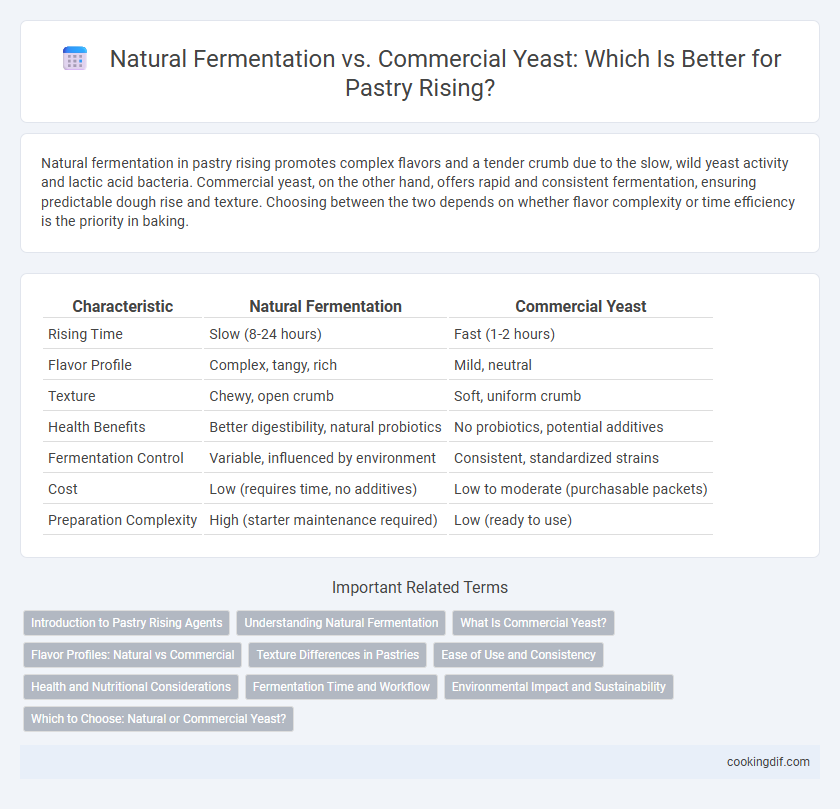Natural fermentation in pastry rising promotes complex flavors and a tender crumb due to the slow, wild yeast activity and lactic acid bacteria. Commercial yeast, on the other hand, offers rapid and consistent fermentation, ensuring predictable dough rise and texture. Choosing between the two depends on whether flavor complexity or time efficiency is the priority in baking.
Table of Comparison
| Characteristic | Natural Fermentation | Commercial Yeast |
|---|---|---|
| Rising Time | Slow (8-24 hours) | Fast (1-2 hours) |
| Flavor Profile | Complex, tangy, rich | Mild, neutral |
| Texture | Chewy, open crumb | Soft, uniform crumb |
| Health Benefits | Better digestibility, natural probiotics | No probiotics, potential additives |
| Fermentation Control | Variable, influenced by environment | Consistent, standardized strains |
| Cost | Low (requires time, no additives) | Low to moderate (purchasable packets) |
| Preparation Complexity | High (starter maintenance required) | Low (ready to use) |
Introduction to Pastry Rising Agents
Natural fermentation relies on wild yeasts and bacteria to leaven pastry dough, producing complex flavors and a tender crumb texture. Commercial yeast, typically Saccharomyces cerevisiae, offers rapid and consistent rising, essential for uniform pastry volume and structure. Understanding the distinct biochemical processes of these rising agents helps bakers control dough development and flavor profiles in artisanal and industrial pastry production.
Understanding Natural Fermentation
Natural fermentation in pastry rising utilizes wild yeast and lactic acid bacteria, producing complex flavors and improved texture through slow fermentation. This process enhances dough digestibility and creates a more aromatic and artisan-quality product compared to commercial yeast. Harnessing the natural microbial ecosystem allows bakers to achieve a unique, nuanced rise that commercial yeast cannot replicate.
What Is Commercial Yeast?
Commercial yeast, often Saccharomyces cerevisiae, is a cultivated strain of yeast designed for consistent and rapid fermentation in pastry making. It produces carbon dioxide quickly, ensuring predictable dough rising times and uniform texture in baked goods like croissants and brioche. Unlike natural fermentation, commercial yeast offers precise control over fermentation speed, making it a staple in industrial and home baking processes.
Flavor Profiles: Natural vs Commercial
Natural fermentation in pastry rising develops complex flavor profiles with subtle tangy and fruity notes, resulting from wild yeast and lactic acid bacteria activity. Commercial yeast offers a more neutral, consistent rise with minimal impact on flavor, allowing the pastry's primary ingredients to dominate taste. Bakers seeking depth and artisan qualities favor natural fermentation, while efficiency and predictability drive the use of commercial yeast.
Texture Differences in Pastries
Natural fermentation produces pastries with complex texture, characterized by an open crumb structure and chewy crust due to the slow fermentation process that allows enzymes to break down starches and proteins. Commercial yeast results in a more uniform and softer texture, with a tighter crumb and lighter crumb consistency because of its rapid rise and predictable fermentation rate. Texture differences impact mouthfeel and crumb resilience, making naturally fermented pastries preferable for artisanal quality.
Ease of Use and Consistency
Natural fermentation relies on wild yeast and bacteria, offering complex flavors but requiring longer fermentation times and more careful temperature control, which may challenge beginners. Commercial yeast provides rapid and predictable rising, ensuring consistent results and greater ease of use for both home bakers and professionals. While natural fermentation enhances artisanal qualities, commercial yeast remains the preferred choice for efficient, reliable pastry production.
Health and Nutritional Considerations
Natural fermentation in pastry promotes the growth of beneficial lactic acid bacteria, enhancing digestibility and increasing bioavailability of nutrients like B vitamins and minerals. Commercial yeast acts quickly but may lead to higher glycemic response and less nutrient complexity due to rapid fermentation. Health-conscious bakers prefer natural fermentation for its potential probiotic effects and improved mineral absorption.
Fermentation Time and Workflow
Natural fermentation requires longer fermentation times, often ranging from 12 to 48 hours, allowing complex flavor development and improved dough texture in pastries. Commercial yeast accelerates rising, typically completing fermentation within 1 to 2 hours, enabling faster workflow and consistent results in high-volume bakery production. Managing natural fermentation demands precise temperature control and planning, while commercial yeast offers predictable timing, facilitating streamlined pastry production schedules.
Environmental Impact and Sustainability
Natural fermentation in pastry rising utilizes wild yeasts and bacteria, significantly reducing reliance on commercial yeast production, which demands industrial energy and resources. This traditional method promotes sustainable practices by minimizing carbon footprints and preserving biodiversity in microbial ecosystems. Consequently, natural fermentation aligns with eco-friendly baking by enhancing environmental resilience and lowering the overall impact of pastry production.
Which to Choose: Natural or Commercial Yeast?
Natural fermentation offers complex flavor development and enhanced texture in pastries due to slow fermentation by wild yeasts and lactic acid bacteria, while commercial yeast provides consistent, rapid rising for precise baking schedules. Choosing between natural fermentation and commercial yeast depends on the desired flavor profile, baking time, and consistency requirements. Artisanal bakers often prefer natural fermentation for richer taste, whereas commercial yeast suits mass production with predictable results.
Natural Fermentation vs Commercial Yeast for pastry rising Infographic

 cookingdif.com
cookingdif.com